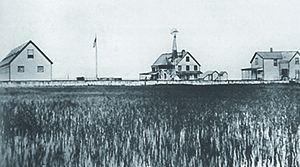Information for the following article was drawn from the resources of the Eastern Shore Room, soon to be expand-ed into the Eastern Shore of Virginia Heritage Center within the ESVA Regional Library to be built in Parksley.
By Curtis Badger
Special to the Eastern Shore Post
The most luxurious of the gunning clubs that sprang up on the Eastern Shore seaside in the late 1800s was the Accomac Club, situated on a point of high marsh between Wachapreague and the north end of Parramore Island. The club was incorporated Jan.12, 1887, with seven members, all of whom were businessmen from New York. The club’s first president was Benjamin W. West, secretary of the Fulton Market Fishmongers Association, and the vice president was S.L. Stoner, president of the same association.
The club grew quickly and limited its membership to 35 men, most of whom were business associates. New members were admitted only by unanimous vote and were required to pay a $100 initiation fee plus $75 in annual dues, billed quarterly.
The club built a large two-storied clubhouse with a wide porch, plus separate dining quarters, a cook-house, boathouse, and numerous other improvements. Old photographs depict the dining room as especially ornate, with intricate woodwork and expensive furniture. An excellent reproduction can be seen at the Barrier Islands Center in Machipongo.
The initial assumption is that the wealthy New Yorkers, isolated in their island womb of privilege, far removed from the sweat and toil of the commoners along the Wachapreague waterfront, probably kept their distance from the local folks. Newspaper accounts of the day, how-ever, tell a different story.
The Peninsula Enterprise, a news-paper published in Accomac, provided regular coverage of the Accomac Club, especially when the annual regatta came around in May. The Countryside Transformed, a digital archive of maps, photographs, and printed media maintained by the Eastern Shore Public Library, has files from the Enterprise dating back to the 1880s, so we can tune in to our computers and read all about the latest news from the Accomac Club.
The Enterprise reported on June 6, 1891, that several hundred local people attended the regatta, where local boaters competed for trophies and prizes. Following the races, visitors returned to the clubhouse “where a sumptuous and elegant dinner, furnished by the Club, was spread, and where costly Madeiras, Hollands, Cognacs, and lager flowed as from a living fountain, of which not a few freely partook.”
Following the feast, prizes were presented to the winning sailors, and speeches were made. Abel Crook, a New York lawyer and secretary of the club, made “one of the most beautiful and thrilling addresses to the winners and to the citizens of Accomac your correspondent has ever heard.” His speech was responded to by George F. Parramore, Esq. “in a felicitous and forcible speech that carried conviction to the hearts of all present.”
The regattas were held annually for a number of years, with the club hosting hundreds of local residents and providing prizes such as gold watches and silver tea sets. A sumptuous dinner would be served, and then a member of the club would make a speech extolling the virtues of Accomac (as it was spelled then) County, and a county representative would respond in turn. In 1896, the celebration featured music by the Cashville Cornet Band.
Many of the old gunning clubs fell victim to a rising sea level and the disastrous storm of 1933. The Accomac Club, however, was a victim of the Great Depression, which eroded the fortunes of most of the members. By the time the ‘33 storm hit, membership was down to “six or seven men.”
The old seaside gunning clubs are a part of local history that leaves no footprint. Most of them long ago washed out to sea. But if you’re heading from the Wachapreague dock out to the Dawson’s Shoal area, look to the south where a cluster of pilings line the edge of the high marsh. A century ago, this was one of the Shore’s special places: the Accomac Club.
Librarian’s note: Readers may see more images from Tom Badger and Curtis Badger’s book, Accomack County, which is available for loan from any of the four ESVA public libraries.
A campaign is underway to fund the new ESVA Heritage Center, which will require specialized architectural design, environmental controls, and equipment. Those wishing to donate or to be recognized with other founders of the Heritage Center should send donations to ESPL Foundation, P.O. Box 554, Accomac, VA 23301, call 757-787-2500, or visit www.shorelibrary.com
Sign in
Welcome! Log into your account
Forgot your password? Get help
Password recovery
Recover your password
A password will be e-mailed to you.



